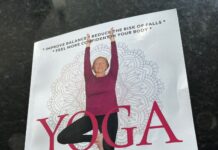by Anne Dimon
Wellness in the Workplace is so much more than simply offering healthy food options and a free membership at a local gym. I recently sat in on the full-day, third annual WellBeing @Work Event held in Toronto, and organized by U.K.-based FOWInsights.
In his welcome notes, Chris Cummings, Managing Director of FOWInsights explained that “many more organizations are taking employee wellbeing in the workplace seriously, and that this annual event – now in 11 cities around the world – allows senior level professionals to share and exchange ideas to put employee wellbeing at the heart of business strategy.” Could your wellness retreat be a post-Covid RX


Event moderator Candace DiCresce, Senior Director Safely & Well-Being, Rogers Communications, pointed out that “mental illness across the world is on the rise” and the need for a sense of well-being is growing. Employees are asking “are wellness initiates being implemented because the company really cares, or is the initiative simply a tool of productivity?” Companies are asking “what they can do and where they can turn for ideas and partnerships to weave into the culture of the organization.”
Here is an extensive list of take-aways from human resources and other experts who presented at this exceedingly worth-the-effort-to-attend event:
Wellness in the Workplace is about Happiness
Sandy McIntosh, Executive Vice-President People and Culture and Chief Human Resources Officer at Telus points out “studies today tell us we are more anxious, depressed and stressed than we have ever been.” He said, “When it comes from the top down, it (a workplace wellness initiative) can be a game changer. Giving employees permission to put their own well-being first, at the very least on an equal footing with profit.” At Telus, they believe that wellbeing stems from a “culture of happiness.” McIntosh says, “We each have a great need for a clear and uncomplicated life.”

So, what is happiness? “People believe happiness is being cheerful and content all the time and always having a smile on your face. But it is not. Being happy and leading a rich life is about taking the good with the bad and learning how to reframe the bad.” She points to the science-based importance of neoplasticity and how we can change and reframe how we see the world. “Switch your mind set, she says. “Reframe and choose happiness.”
Wellness in the Workplace is about Trust
Presenter Liz Kimmel, Chair and CEO at Edelman Canada focused on the Edelman Trust Barometer – “the largest trust barometer in the world,” she said. According to Kimmel, the barometer has seen a significant decline in trust of institutions around the world but an increase in trust of companies. Consequently, she pointed out, company websites, blogs and newsletter are becoming more important as the values and cultures of companies are becoming increasing important to the employees who work for them.
Additionally, “employees are looking for leadership from CEOs,” she said. Their Trust Barometer surveys indicate that 74% of women and 78% of men say CEOs should take a lead role on key social issues rather than wait for governments to impose change. She cited the example of Walmart and its recent decision to discontinue sales of certain gun ammunition. “There is a direct correlation between trust and wellbeing,” she said, so it makes sense that building trust in an organization helps lead to a greater sense of wellbeing among employees. She also pointed out that “women trust less than men, and also have higher expectations. They have mobilized and are demanding change.”
Wellness in the Workplace is about the Employee Experience
Matt Price, Head of Human Resources Canada at Unilever talked about the Age of Paradox based on Charles Hardy’s book of the same name originally published in 1994. Price said, “disruption, uncertainty, the speed of change, globalization and changing demographics are at the root of our increasing mental health issues. The impact is real.”

So what specific things is Unilever doing to enhance the employee experience under the banner of Wellbeing at Work? Here are just two:
About five years ago Unilever created what Price calls “an environment of agility,” which encompasses flexibility of hours, the option to attend meetings or not, a variety of “office” spaces from which individuals can choose to work, and impromptu scrum teams assigned to tackle specific issues. “Agility amplifies the employee experience,” he said, and called it a “wellbeing enabler.”
Unilever also introduced a one-day program – run multiply times a year – to help employees find their individual sense of purpose. Attendance is, of course, optional. “We are building an ecosystem to support a movement.” he says. And, in keeping with the science-based importance of “community” one of Unilever’s popular brands, Lipton Tea, has newly launched a purpose-driven Fostering Connections initiative.
Wellness in the Workplace is about Permission
Katheryn Bowen, Director of Employee Engagement Programs at Sales Force, concentrates on the importance of Permission.
- Permission to step away from one’s desk, and to totally step away from work
- Permission to evaluate if the meetings you are invited to attend are really necessary
- Permission to shut the door on work at the end of the day and do something totally different
Bowen also reminded all of us in the audience that “Healthy, happy employees are engaged employees.” So SalesForce has launched Camp B-Well, a corporate program based on a national forest theme, and built on the cornerstones of food, sleep, movement, time to disconnect, mental health and financial health. They have set up an internal web site including a blog allowing employees to share their personal stories, team successes, healthy-cooking videos from the staff chef, promotion of employees benefits and a chatter section allowing people to simply engage about topics of their choosing.
Wellness in the Workplace is about Belonging
Sacha de Klerk, Head of Diversity & Inclusion at Norton Rose Fulbright spoke about fostering a sense of belonging to drive a feeling of inclusion and wellbeing. She said, “Feeling that one belongs is the secret sauce to employees being more productive, happier, less stressed and more engaged. Feeling connected (belonging) is a big part of happiness and wellbeing.”

So, how do we create a greater sense of belonging in our workplaces? A few suggestions from de Klerk:
- Give permission to employees to bring their authentic selves to work. They can be who they are and feel comfortable in the work environment.
- Bring people together around shared values.
- Communicate company news and strategies frequently and in various forms.
- Celebrate successes socially.
- Set up employee resource groups.
- Recognize diversity. For instance, with food selections on staff cafeteria menus, scheduling of meetings and events (eg. observing religious holidays)
- Set up video conferences for those who work remotely.
- Create a culture where it is ok to make a mistake and ok to offer feedback on that mistake.
Wellness in the Workplace is about Ergonomics
“The most important thing in the room is not the furniture, it’s the people,” said Emily Dunn, Workplace Knowledge Consultant with Herman Miller.

From an ergonomics perspective, company executives need to ask themselves “what is inhibiting individuals from doing the task at hand – is it light, is it noise, is it the view, or something else? According to Dunn, “people need to have options on where to work and permission to move and relocate to another space if they need to.” She said Variety and Permission go hand-in-hand and allow employees to control the space for their own work environment. And, when it comes to variety, work environment designers need to ask themselves these questions: Should there be a selection of different types of spaces available to employees? If yes, what kind of spaces:–Spaces to interact? Quiet spaces? Private spaces? Napping zones? And, should certain spaces be bookable in advance of use?
Of course, wellness and wellbeing mean different things to different people and there certainly is no one size fits all.
Here are other ways presenters are working wellness initiatives into their cultures, plus other take-aways and suggestions for anyone looking to incorporate a bit more “wellbeing” into their own workplace environments.
- Debbie Singh, EVP People & Culture at the Canadian Cancer Society told the audience that the organization created a compassion care team to combat “compassion fatigue” suffered by front line employees who handle day-to-day calls from those with cancer.
- “Integration” is a key word. Wellness must be imbedded into the culture of the workplace. Cheryl Kerrigan, VP People says BlueCat encourages Fitness Fridays. Salad Club Wednesdays and Walking Meetings.
- A Wellness Week with step challenges, speakers and lunch and learn sessions.
- Look for some programs to run outside of HR by interested divisions and teams.
- Acknowledged that mental health is important, and that it is ok to talk about it. Give permission to share personal stories and create a safe space for conversations around the topic.
- Look at existing benefits plan. For instance, are dental benefits deemed more important than the need to see a mental health therapist or psychiatrist?
- Brent Reed, Head of Talent at SnapTravel says the company has set up a Compassion Fund for those who may need sudden financial help.
- Give employees time off to volunteer
- Offer a monthly reimbursement (eg. $100) spent on certain wellness items
- Create workplace meditation zones and scheduled sessions
- Encourage employees to participate in activities away from his/her main work station
- Make team events more active – hiking, cycling or skiing rather than lunch or dinner
- Provide employees with a daily fruit basket for day-time snacking
- Make sure other healthy snacks (eg. low sugar granola bars, protein shakes) available
- Set a number of “personal wellbeing days” that employees are allowed to take each year
Overall, the event provided an excellent overview of what Wellness/Wellbeing in the Workplace initiatives should include, along with plenty of practical suggestions for getting started.
Here’s a schedule of other cities where Wellbeing @Work Events are taking place:











